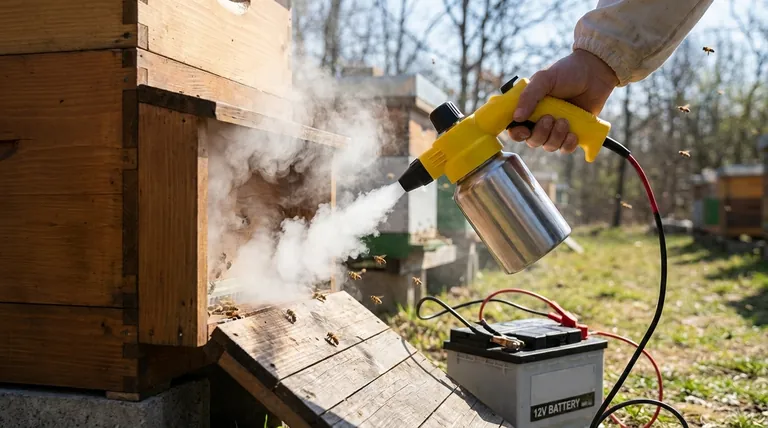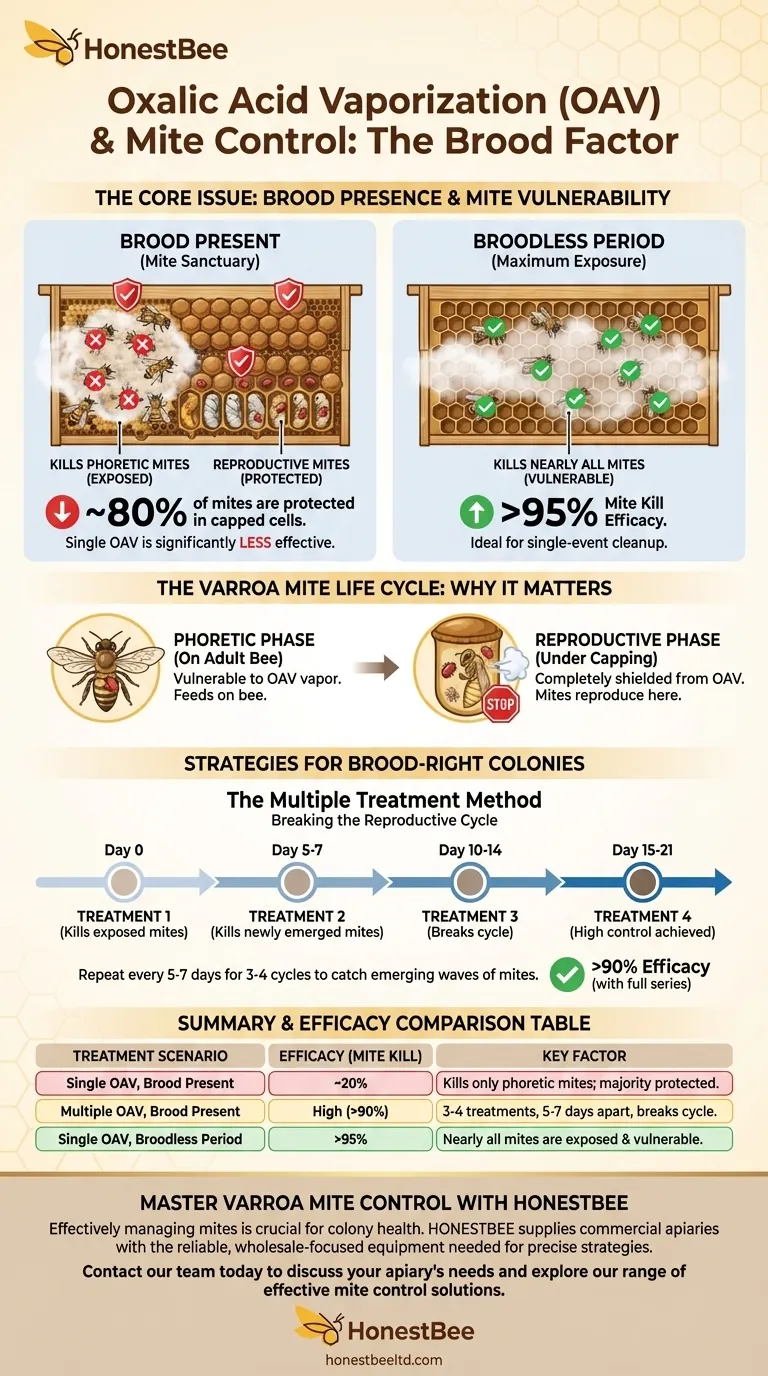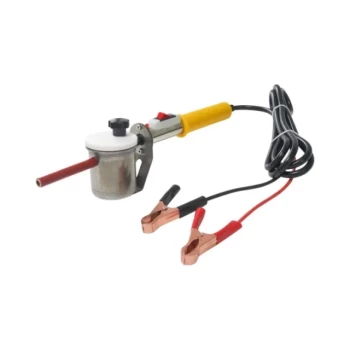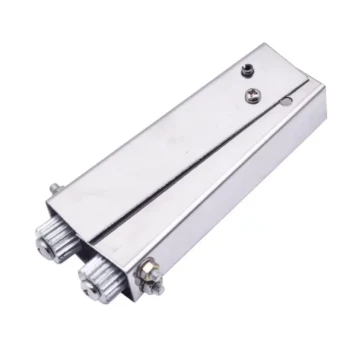In short, oxalic acid vaporization is significantly less effective when brood is present in the hive. The treatment only kills Varroa mites on adult bees (phoretic mites), but it cannot penetrate the wax cappings of brood cells. This leaves the majority of the mite population, which is reproducing inside those cells, completely unharmed.
The core issue is not the chemical, but the pest's life cycle. Because a large portion of the Varroa mite population hides under capped brood, a single oxalic acid vaporization (OAV) treatment in a brood-right hive will only address a fraction of the total infestation.

The Varroa Mite's Life Cycle: Why It Matters
To effectively use any mite treatment, you must understand your adversary. The Varroa mite's two-phase life cycle is the central reason OAV's effectiveness varies so dramatically.
Phoretic vs. Reproductive Mites
A mite's life is split into two stages. The phoretic phase is when the mite is attached to an adult bee, feeding on its fat bodies and moving around the hive. Mites in this stage are exposed and vulnerable to oxalic acid vapor.
The reproductive phase begins when a female mite enters a brood cell just before it is capped. She is sealed inside with the developing bee larva, where she lays her eggs. These mites are completely shielded from OAV by the wax capping.
Capped Brood: The Mite Sanctuary
Think of capped brood cells as impenetrable bunkers for Varroa mites. When you apply OAV, the vapor circulates throughout the hive and kills the exposed phoretic mites.
However, the mites safely reproducing under the cappings are unaffected. When these new bees emerge, a new wave of mites emerges with them, quickly re-infesting the colony.
The Numbers Tell the Story
In a healthy, growing colony with a significant amount of brood, up to 80% of the total mite population can be in the reproductive phase under capped brood at any given time.
This means a single OAV treatment might only kill 20% of the mites in your hive, which is not an effective level of control.
Strategies for Using OAV in a Brood-Right Colony
While a broodless period is ideal, it is not always practical, especially if mite counts spike during the spring or summer. In these cases, you must adapt your strategy.
The Multiple Treatment Method
The standard approach for a brood-right hive is to perform a series of OAV treatments. The goal is to kill the waves of mites that emerge with new bees before they have a chance to enter another cell to reproduce.
A common and effective schedule is one OAV treatment every 5-7 days, repeated for 3 to 4 cycles. This timing is designed to span the honey bee's sealed brood cycle, catching mites as they emerge.
Why This Method Works
By treating repeatedly, you are systematically depleting the phoretic mite population. As new bees and mites emerge from capped cells, the next treatment kills those newly emerged mites. This breaks the reproductive cycle.
While more labor-intensive, this method can achieve a high level of mite control without harming the bees or contaminating honey.
Understanding the Trade-offs
Choosing a treatment plan means weighing efficacy against practicality. There is a clear hierarchy of effectiveness when it comes to oxalic acid.
The Gold Standard: Broodless Treatment
A single OAV application during a natural brood break—such as in late fall or early winter in colder climates—is the most effective use of this tool. Efficacy rates often exceed 95% mite kill.
This is because virtually all mites are in the phoretic stage, making the entire population vulnerable to the treatment.
The Necessary Compromise: Brood-Right Treatment
The multiple-treatment method during the main season is a compromise. It is a highly valuable tool because it is effective on mites while being gentle on bees and safe for use during a honey flow (always follow local regulations).
However, its effectiveness depends entirely on correct timing and completing the full series of treatments. Missing a treatment can allow a wave of mites to survive and reproduce, undermining your efforts.
Choosing Your OAV Strategy
Your decision should be based on the time of year, the state of your colony, and your overall mite management goals.
- If your primary focus is a highly effective, single-event cleanup: Perform one OAV treatment when the colony is naturally broodless in late fall or winter.
- If your primary focus is reducing high mite loads during the honey season: Use a series of 3-4 OAV treatments spaced 5-7 days apart to break the mite life cycle without contaminating honey.
- If your primary focus is creating clean new colonies: Treat both the parent colony and the new, temporarily broodless split or nuc with OAV to drastically lower the initial mite pressure.
Mastering oxalic acid is about timing your attack to the Varroa mite's life cycle, turning their biology against them.
Summary Table:
| Treatment Scenario | Efficacy (Mite Kill) | Key Factor |
|---|---|---|
| Single OAV, Brood Present | ~20% | Kills only phoretic mites; 80% of mites are protected in capped cells. |
| Multiple OAV, Brood Present | High (>90% with full cycle) | 3-4 treatments, 5-7 days apart, breaks the mite reproductive cycle. |
| Single OAV, Broodless Period | >95% | Nearly all mites are exposed (phoretic), making them vulnerable. |
Master Varroa Mite Control with HONESTBEE
Effectively managing mites is crucial for the health of your colonies and the success of your operation. HONESTBEE supplies commercial apiaries and beekeeping equipment distributors with the reliable, wholesale-focused supplies needed to implement these precise treatment strategies.
Let us help you protect your investment. Contact our team today to discuss your apiary's needs and explore our range of effective mite control solutions.
Visual Guide

Related Products
- 12V Bee Mite Removal Evaporator Oxalic Acid Vaporizer for Bee Fumigation Treatment 180W Atomization
- Adjustable Formic and Acetic Acid Dispenser for Bee Mite Treatment
- Professional Bamboo Queen Isolation Cage
- Reusable Clear Small Hive Beetle Traps for Beehives Beetle Trapping Tools
- Commercial 48-Frame Stainless Steel Honey Extractor
People Also Ask
- What are the two popular methods for applying oxalic acid? Choose the Best Varroa Mite Treatment
- Can oxalic acid vaporization be used with honey supers on the hive? Ensure Legal Compliance & Honey Safety
- What are the methods of administering oxalic acid against Varroa? Drip vs. Sublimation Explained
- What should be done after applying the vapor? A Step-by-Step Guide to Sealing Your Hive
- What is the overall goal of using oxalic acid in late fall for beekeepers? Maximize Winter Survival with a Broodless Treatment



















